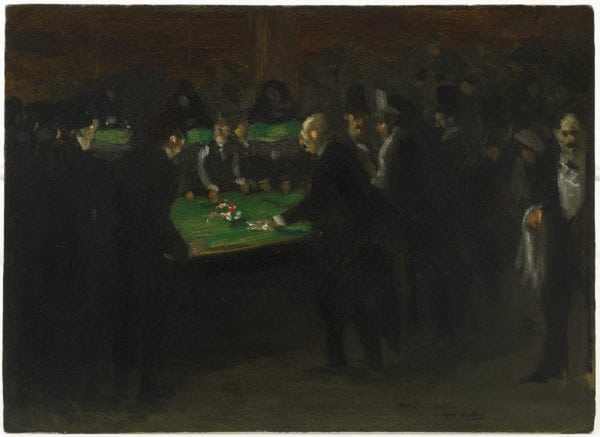Billards in Paris, 1905
Guy Pene du BoisOil on board
9 1⁄2 × 13 inches
Signed
Grand Café Bd. Des Capucines Paris
Provenance
Yun Gee, San Francisco, New York, and Paris
Ellen Berland, Conneticut, c. 1930’s
Laura Berland, Lincoln, Massachusettes
Private collection, New York and Florida
Billiards in Paris is typical in its scale and intimate feeling of the work Guy Pène du Bois created during the year he spent in Paris, upon completing his artistic training with luminaries such as William Merritt Chase (1849-1916) and Robert Henri (1865-1929) at the New York Art School. After a stop in London, which Pène du Bois found gloomy and uninteresting, he arrived in Paris with his father. Pène du Bois fell in love with the city, renting a studio on the left bank, and setting out to develop his painting style. At the New York Art School, Henri had always encouraged his students with the exhortation: “Paint what you feel. Paint what you see. Paint what is real to you.”[i] With Henri’s words still ringing in his ears, Pène du Bois began painting what he knew – the world right in front of him. A regular at cafés such as the Café du Dôme and Closerie du Lilas, Pène du Bois was a young man about town, and it is easy to imagine him walking into a billiards club on the Boulevard des Capucines.[ii]
Indeed, viewing the picture, we feel as if we too have just entered the club. A bright green billiard table set at a diagonal dominates the dark composition. Encircling the table are many figures, dressed in dark clothes and top hats. A bald, mustachioed gentleman in the middle of the composition rests his hand flatly on the table. To his right, stands a woman, differentiated from the men by her white stole and elegant hat. Across the table from this couple stands a man who faces the viewer. He is in shirtsleeves and is bareheaded. While it is often assumed that the bald gentleman is racking the balls, it is possible that the man without a jacket is an employee of the club, who is organizing the game. Regardless, there are many hands on the table; a clue that the play has not yet commenced. Finally, a waiter stares out at us from the right corner, a cloth napkin draped over his right arm. He is the only figure to engage the viewer directly. Interestingly, Pène du Bois has cut through his body midway, imparting a sense of his movement towards the viewer.
The scene is quite dark and loosely painted. Henri had encouraged his students to use a dark and somber palette: he believed it was more true to life. Three electric lights with green glass shades provide the only light, brilliantly illuminating the table. All else is thrown into deep shadows, so that while a crowd is hinted at, it is hard to distinguish any figures beyond the central group, the nebulous quality enhancing the clubby atmosphere. Henri also exhorted his students to paint quickly, in order not to lose any of one’s ideas. For Billiards in Paris, ears, lips, and cheeks, are dabbed in with tiny red and pink strokes, conveying rudimentary detail. Cursory strokes create the woman’s stole, the waiter’s napkin and his shirt. The greatest texture in the work is used to define the red and white balls used to play French or carom billiards.
Over the next decade, Pène du Bois’s developed his stylized images of fashionably dressed men and women in a cosmopolitan world. This small painting of a billiards club predates those works, yet it shares with them a detached interest in the smart set and their diversions.
[i] These often quoted words were actually recorded by John Sloan in his notes. John Sloan, Manuscript Collection, on deposit at the Delaware Art Museum. Cited by James Tottis, “Bars, Cafés, and Parks: The Ashcan’s Joie de Vivre,” in Life’s Pleasures: The Ashcan Artists’ Brush with Leisure (Detroit: Detroit Institute of Art, 2007), p. 12.
[ii]The location is inscribed on the paintings surface. Billiards are an unusual, but not unheard of, theme in paintings. Vincent Van Gogh, The Night Café (1888, Yale Art Gallery, New Haven) is perhaps the best known. It is not clear that Pène du Bois would have been familiar with Van Gogh’s work.
Literature
- H. Alexander Rich, “Artist or Critic?: Guy Pène du Bois and the Search for Artistic Identity”, PhD dissertation., Institute of Fine Arts, New York University, 2013, pp. 57-59, fig. 7, p. 294, ill. (color).

